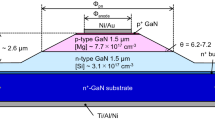Abstract
It is well-known that SiC wafer quality deficiencies are delaying the realization of outstandingly superior 4H-SiC power electronics. While efforts to date have centered on eradicating micropipes (i.e., hollow core super-screw dislocations with Burgers vectors > 2c), 4H-SiC wafers and epilayers also contain elementary screw dislocations (i.e., Burgers vector = lc with no hollow core) in densities on the order of thousands per cm 2, nearly 100-fold micropipe densities. While not nearly as detrimental to SiC device performance as micropipes, it has been previously shown that diodes containing elementary screw dislocations exhibit a 5% to 35% reduction in breakdown voltage, higher pre-breakdown reverse leakage current, softer reverse breakdown I-V knee, and concentrated microplasmic breakdown current filaments when measured under DC testing conditions. This paper details the impact of elementary screw dislocations on the experimentally observed reverse-breakdown pulse-failure characteristics of low-voltage (< 250 V) small-area (< 5 × 10-4 cm2) 4H-SiC p+n diodes. The presence of elementary screw dislocations did not significantly affect the failure properties of these diodes when subjected to non-adiabatic breakdown-bias pulsewidths ranging from 0.1 μs to 20 μs in duration. Diodes with and without elementary screw dislocations exhibited positive temperature coefficient of breakdown voltage and high junction failure power densities well above the failure power densities exhibited by highly reliable silicon power rectifiers. This preliminary result, based on measurements from one wafer of SiC diodes, suggests that highly reliable low-voltage SiC rectifiers may be attainable despite the presence of elementary screw dislocations.
Similar content being viewed by others
References
P. G. Neudeck, J. Electron. Mater. 24 (4), 283–288 (1995).
P. G. Neudeck and J. A. Powell, IEEE Electron Device Lett. 15 (2), 63–65 (1994).
M. Dudley, S. Wang, W. Huang, C. H. Carter, Jr., and C. Fazi, J. Phys. D 28 A63–A68 (1995).
S. Wang, M. Dudley, C. H. Carter, Jr., V. F. Tsvetkov, and C. Fazi in Applications of Synchrotron Radiation Techniques to Materials Science, edited by L. Terminello, N. Shinn, G. Ice, K. D’Amico, and D. Perry (Mater. Res. Soc. Proc. 375, Pittsburgh, PA 1995), pp. 281–286.
W. Si, M. Dudley, R. Glass, V. Tsvetkov, and C. H. Carter, Jr., J. Electron. Mater. 26 (3), 128–133 (1997).
W. Si and M. Dudley in Silicon Carbide. III-Nitrides. and Related Materials, edited by G. Pensl, H. Morkoc, B. Monemar, and E. Janzen (Materials Science Forum 264–268, Trans Tech Publications, Switzerland 1998), pp. 429–432.
S. Wang, M. Dudley, C. H. Carter, Jr., and H. S. Kong in Diamond. SiC and Nitride Wide Bandgap Semiconductors, edited by C. H. Carter, Jr., G. Gildenblat, S. Nakamura, and R. J. Nemanich (Mater. Res. Soc. Proc. 339, Pittsburgh, PA 1994), pp. 735–740.
J. A. Powell, D. J. Larkin, P. G. Neudeck, J. W. Yang, and P. Pirouz in Silicon Carbide and Related Materials, edited by M. G. Spencer, R. P. Devaty, J. A. Edmond, M. A. Kahn, R. Kaplan, and M. Rahman (Institute of Physics Conference Series 137, Bristol, UK 1994), pp. 161–164.
V. F. Tsvetkov, R. C. Glass, D. Henshall, D. A. Asbury, and C. H. Carter, Jr., in Silicon Carbide, III-Nitrides. and Related Materials, edited by G. Pensl, H. Morkoc, B. Monemar, and E. Janzen (Materials Science Forum 264–268, Trans Tech Publications, Switzerland 1998), pp. 3–8.
P. G. Neudeck, W. Huang, and M. Dudley to appear in Power Semiconductor Materials and Devices, edited by S. J. Pearton, R. J. Shul, E. Wolfgang, F. Ren, and S. Tenconi (Mater. Res. Soc. Proc. 483, Warrandale, PA, 1998).
S. M. Sze, Physics of Semiconductor Devices, 2nd ed., Wiley-Interscience, New York, 1981, pp. 169–175.
B. J. Baliga, Modem Power Devices Wiley-Interscience, New York, 1987, pp. 314–318.
L. W. Ricketts, J. E. Bridges, and J. Miletta, EMP Radiation and Protective Techniques, Wiley, New York, 1976.
R. N. Ghose, EMP Environment and System Hardness Design, D. White Consultants, Gainesville, VA, 1984, pp. 4.1–4.31.
D. C. Wunsch and R. R. Bell, IEEE Trans. Nucl. Sci. 15 (6), 244–259 (1968).
A. Zywietz, K. Karch, and F. Bechstedt, Physical Review B 54 (3), 1791–1798 (1996).
C. Kittel, Introduction to Solid State Physics, 6th ed., Wiley, New York, 1986, pp. 99–122.
G. A. Slack, J. Appl. Phys. 35 (12), 3460 (1964).
P. G. Neudeck and C. Fazi, J. Appl. Phys. 80 (2), 1219–1225 (1996).
FluorinertTM, 3M Company, St. Paul, MN 55144.
G. Gradinaru, V. P. Madangarli, and T. S. Sudarshan, IEEE Trans. Electron Devices 41 (7), 1233–1238 (1994).
P. G. Neudeck, D. J. Larkin, J. A. Powell, L. G. Matus, and C. S. Salupo, Appl. Phys. Lett. 64 (11), 1386–1388 (1994).
Author information
Authors and Affiliations
Rights and permissions
About this article
Cite this article
Neudeck, P.G., Huang, W., Dudley, M. et al. Non-Micropipe Dislocations in 4H-SiC Devices: Electrical Properties and Device Technology Implications. MRS Online Proceedings Library 512, 107–112 (1998). https://doi.org/10.1557/PROC-512-107
Published:
Issue Date:
DOI: https://doi.org/10.1557/PROC-512-107




